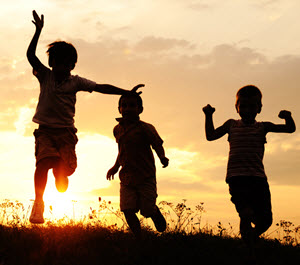According to the National Child Traumatic Stress Network (NCTSN), a child may have a traumatic reaction following a sudden and unexpected death of a loved one (2009). If the child’s responses are severe or prolonged, and interfere with the child’s functioning, the child may have a condition called Traumatic Grief. The signs and symptoms of traumatic grief are the same as for traumatic events (which will be discussed later in this article). However, you may notice a few other reactions in traumatic grief, such as:
Survivor’s guilt: Some children may wonder why they were spared because “they feel no better than, or even inferior to, the person who died”. It is helpful to mention that this is a normal feeling, but correct inaccurate thoughts. Reassure them that they are just as important as the person who died. Try to refrain from comparing the child to the individual who died, as this may not be helpful.
Remorse or guilt about perceived “bad” behaviors: It is not unusual for the surviving child to express regrets or remorse for previous “bad” behaviors that may have upset the individual who died. NCTSN identifies some examples such as; the surviving child could have been “nicer” to the individual when they were alive. They may even believe that their behavior may have caused the death. It is helpful to normalize this thought but reassure the child that sometimes children may fight and argue with the people they love, and explain what caused the death and that they were not responsible. It is helpful to explain that children feel angry or have unkind thoughts every once in a while, but these thoughts cannot cause a death to happen.
Ongoing connections with the deceased family member: As happy memories, and experiences may be comforting for the surviving child, it can be concerning if these connections create a negative impact on the child. This is observed when the child compares his/ herself to the deceased family member creating self-inadequacies and “replacing the [family member] by being just like him or her” (NCTSN). It is helpful to redirect the child on comforting memories and experiences, while allowing him/ her to appreciate their own unique qualities, traits, and strengths; reminding him/ her how their uniqueness supports and strengthens the family.
Questioning their belief and Faith: Surviving children may have questions regarding their Faith and religious background, such as questioning a Faith that would allow their loved one to die. While, younger children may have difficulty understanding the concept of death. It is helpful to discuss this topic in a concrete, age-appropriate explanation of what happened while incorporating cultural and religious beliefs.
Signs and Symptoms of Trauma:
 Not every child who has experienced a traumatic event will exhibit high-stress related reactions to the trauma or related psychiatric disorders. However it is important to be aware of the signs and symptoms to know when to seek professional help. Signs and symptoms to be aware of are:
Not every child who has experienced a traumatic event will exhibit high-stress related reactions to the trauma or related psychiatric disorders. However it is important to be aware of the signs and symptoms to know when to seek professional help. Signs and symptoms to be aware of are:
Nightmares: Sometimes nightmares are not about the traumatic event, but may be more symbolic such as monsters, demons, or any other scary figure, and/ or frightening dreams without recognizable content. Unlike other nightmares, these nightmares may be more intrusive, and occur more often.
Constant replay of trauma: Some children may be able to verbalize their persistent thoughts of the traumatic event, while other children may have trauma specific re-enactment in repetitive play themes such as role play, art, and doll play… etc.
Ongoing negative mood: Some children would experience persistent inability to experience positive emotions. It is normal for children to feel sadness, anger, and confusion but when these emotions become overwhelming the child may exhibit angry/ violent behaviors towards self, and others. Explosive behaviors towards property and/ or animals, inconsolable crying, and aches and pains without a medical cause
Attempting to avoid memories: It is normal for children to occasionally avoid anxiety-provoking memories of the trauma and slowly re-explore these distressing memories with a trusting adult. However, it becomes a concern when the child exhibits diligent efforts to avoid external reminders such as people, place, activities, conversations, situations, and objects for the purpose of avoiding the distressing memory, thought, or feeling.
Disturbances in sleep and eating habits
Difficulty with concentration: Some children may exhibit symptoms consistent to ADHD, but please be aware that it may not be ADHD. A good way to determine the difference is to decide if the symptoms increased since the traumatic event. Difficulty with concentration is observed as incompletion of tasks (including school work, and chores), inability to sit still, and fidgeting more than usual are a few identified behaviors.
Exaggerated startle response: This is observed as “always on edge”, “restlessness”, . Children may complain of feeling “panicky”, or “scared”, especially with internal or external cues that symbolize or resemble an aspect of the traumatic event.
Socially Withdrawn
Showing less interest or participation in favorite activities and play
What You Can Do:
Consistent parents or caregivers, who provides love regardless of the child’s behaviors, can greatly strengthen a child’s resilience to traumatic events
 Most children who experienced traumatic grief may not need professional help, and are capable of successfully processing the loss without trauma related disorders through resilience. Resilience is the ability to “bounce back” (American Psychological Association, 2018) from difficult situations, or returning to normal daily activities after a traumatic event.
Most children who experienced traumatic grief may not need professional help, and are capable of successfully processing the loss without trauma related disorders through resilience. Resilience is the ability to “bounce back” (American Psychological Association, 2018) from difficult situations, or returning to normal daily activities after a traumatic event.
Adults and children cope with trauma differently, and studies (American Academy of Pediatrics, 2015, American Psychological Association, 2018, Center on The Developing Child, 2018, and Ginsburg, 2015) shows that consistent parents or caregivers, who provides love regardless of the child’s behaviors, can greatly strengthen a child’s resilience to traumatic events. The seven C’s, created by Dr. Kenneth Ginsburg (Ginsburg, 2015) is an easy and popular reference for parents/ caregivers to help children build resilience.
Competence is the child feeling that they can handle the aftermath of the trauma effectively. Parents can strengthen competence by:
a. Focusing on the child’s individual strengths
b. Empowering the child to make decisions
c. Not comparing the child to other siblings and/ or children
Confidence is the child’s belief in their own abilities during the aftermath of the trauma. Parents can strengthen confidence by:
a. Identifying the best in the child so that (s)he can see this too
b. Praising the child when (s)he does well
c. Not pushing the child, or temporarily lessening the requirement to do well in school and home activities
Connection with family members and peers, following a trauma, creates a sense of security, and reduces other destructive paths to love and attention. Parents can improve connection by:
a. Building a sense of physical safety, and emotional security in the home
b. Allowing expression of all emotions through play, art, writing, discussions… etc.
c. Creating a space to discuss conflicts openly
Character is developing, or modifying, a set of morals and values to determine right from wrong, specifically regarding right and wrong of the traumatic event. Parents can help build character by:
a. Demonstrating how behaviors affect others
b. Helping the child recognize they are a caring person.
c. Encouraging the development of spirituality
d. Avoiding racist, and hateful statements or stereotypes
Contribution to society is when the child realizes the work is a better place because (s)he is in it; helps develop purpose and motivation. Parents can encourage the child to contribute by:
a. Stressing the importance of serving others by modeling generosity
b. Creating opportunities for the child to contribute in the community
Coping is when the child has learned to adjust to the stress of the trauma. Coping can teach ways to overcome future life challenges. Parents can teach coping by:
a. Modeling positive coping strategies, consistently.
b. Guiding the child on positive behaviors versus telling him/ her to stop the negative behavior
c. Understanding many risky behaviors are attempts to alleviate stress and pain in the child’s life
Control is allowing the child to realize that (s)he can control the outcomes of his/ her decisions. This will allow the child to realize (s)he have the ability to bounce back. Parents can encourage control by:
a. Helping the child realize that life’s events are not purely random but a result of another individual’s choices and actions
b. Using discipline to not punish or control, but to teach the child that there are consequences to behaviors.
When to Seek Help:
The seven C’s, created by Dr. Kenneth Ginsburg (Ginsburg, 2015) is an easy and popular reference for parents/ caregivers to help children build resilience.
It is imperative to seek help when symptoms begin to interfere with the child’s day to day functioning, such as difficulty with school, participating in community activities, and connecting with friends and family. Other signs of when to seek help are when symptoms are beginning to affect the patient’s physical health, such as aches, pains, headaches, upset stomach… etc.
There are many mental health professionals (LCSW, LMHC, LMFT, LPC, NCC, Psychologist, and Psychiatrists) who are capable of providing trauma-based play therapy to help process the trauma and allow your child to live with these memories without reliving the trauma. Failure of seeking timely help may result in impaired social and relational skills, increased symptoms such as depression, anxiety, and conduct disorders leading to severe mental illness, significant risk of self-medication through substance abuse or other self-destructive behaviors, and Post Traumatic Stress Disorder (PTSD).
References:
American Academy of Pediatrics (2018). Building Resilience in Children from https://www.healthychildren.org/English/healthy-
living/emotional-wellness/Building-Resilience/Pages/Building-Resilience-in-Children.aspx on 5/31/2018
American Psychiatric Association (2013). Diagnostic and Statistical Manual of Mental Disorders Fifth Edition. American Psychiatric
Publishing. Washington, DC & London England
American Psychological Association (2018). Resilience Guide for Parents and Teachers. From
http://www.apa.org/helpcenter/resilience.aspx on 5/31/2018
Center on the Developing Child. Harvard University (2018). Resilience. From https://developingchild.harvard.edu/science/key-
concepts/resilience/ on 5/31/2018
Ginsburg, Kenneth, MD (2014). Building Resistance in Children and Teens: Giving Kids Roots and Wing. American Academy of
Pediatrics.
National Child Traumatic Stress Network Child Traumatic Grief Committee. (2009). Sibling Loss Fact Sheet Sibling Death and
Childhood Traumatic Grief: Information for Families. Los Angeles, CA & Durham, NC: National Center for Child Traumatic Stress.
Perry, Bruce and Rubenstein, Jana (2017). The Child’s Loss: Death, Grief, and Mourning. Scholastic, Inc.



